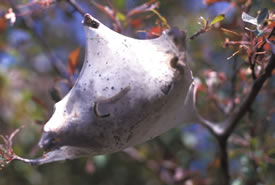

Eastern tent caterpillar tent-web
|
|
| Severity: | 2 out of 5 |
| Frequency: | 2 out of 5 |
| Symptoms: | A silk nest/tent at a branch crotch and defoliation in the spring are the main symptoms. |
| Cycle: | The insect over winters in an egg mass that is wrapped around twigs no thicker than a pencil. Eggs begin to hatch as new growth begins to emerge. The small caterpillars crawl down the branch to a branch crotch. Working as a group, each group of caterpillars from an egg mass spins their own silk tent in the branch crotch. Initially, there is one tent for eachgroup. Six to eight weeks after hatching the caterpillars leave the tree to pupate. Cocoons are white to yellowish. The adult moths appear in June-July. Eggs are laid on twigs in Illinois soon after. Larvae are usually black with a white or yellowish stripe down their back. In addition there are blue spots between two yellow stripes that run down both sides of the caterpillar. The caterpillars are also "hairy". Adults are tan to brown with two white stripes across each forewing. |
| Management: | Physically crushing the nest when the caterpillars are in the nest, during the night or on cloudy days greatly helps reduce feeding damage. Finding and removing these egg masses while the tree/shrub is dormant andleafless during the winter, eliminates damage to the tree the following spring. Bacterial insecticides are effective against this insect. |
| Associated trees: | |